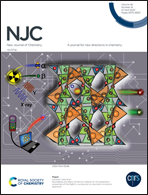Strong absorber vs. strong emitter in extended π-conjugated systems: a carbo-benzene – benzothiadiazole chromophore†
Abstract
In the search for carbo-benzene derivatives with sizable photoluminescent properties, e.g. with the view to measuring the two-photon absorption cross-section with the efficient TPEF method (vs. the z-scan method), a thienyl-benzothiadiazole (BTD) motif was envisaged as an intrinsic fluorophoric substituent through an acetylenic linker. A quadrupolar tetraphenyl-carbo-benzene with 2 BTD-containing substituents was synthesized from a key [6]pericyclynedione dielectrophile and 2 equiv. of a dihexylthienylbenzothiadiazolylacetylene nucleophile. Reductive aromatization of the resulting [6]pericyclynediol was found to occur in 20% yield using SnCl2 only, a quite high yield in the absence of HCl. The parent benzenic derivative was obtained by Sonogashira coupling of 1,4-diodobenzene with 2 equiv. of the same terminal alkyne, providing a new fluorophoric oligophenyleneethynylene derivative ([3]OPE) emitting at λem = 550 nm with a quantum yield of ΦF = 70%. For the highly carbon-rich carbo-benzene-BTD conjugate, the solubility provided by the four hexyl substituents allowed full characterization by 1H–13C NMR spectroscopy and voltammetry, in particular giving a very small absolute potential for a reversible reduction at E1/2 = −0.53 V/SCE. A classical UV-vis absorption spectrum was recorded, with a maximum band at λabs1 = 499 nm (ε1 = 5.79 104 L mol−1 cm−1). UV-Vis emission spectra were also recorded, showing residual intrinsic fluorescence of the functional substituents at λem = 570 nm, at a local minimum of the absorption spectrum before a secondary band at λabs2 = 612 nm (ε2 = 1.75 104 L mol−1 cm−1). Nevertheless, accurate measurements allowed the determination of the carbo-benzene's fluorescence quantum yield: ΦF = 0.3%. A short analysis of electron delocalization is provided from basic DFT calculations.



 Please wait while we load your content...
Please wait while we load your content...